Keen to see how the new Yamaha SCR950 fares in the real world, Nathan Millward takes it on a trip along the east coast, through Skegness, Scarborough and Whitby.
The rain was fierce in Scarborough. I’d not seen a downpour like it for quite some time and the only thing to do was huddle under the shelter of the Oasis Café on the seafront. Eventually it passed and I carried on my journey to Whitby.

I was riding the new Yamaha SCR950, a bike that had grabbed my attention for the fact is was something a bit different. Badged as a scrambler, it’s part of the Japanese company’s Sport Heritage range with styling input from official Yamaha tuners Faster Sons (the name emblazoned across the crossbar pad). To make it, Yamaha has taken the XV950 cruiser, fitted a new subframe to raise the seat height from 690mm to 830mm, replaced the 17in front wheel with a new spoked 19in wheel, shod with light trail friendly Bridgestone Trail Wing tyres, widened the bars, and added gaiters to the forks. The finishing touch is the new 13-litre seamless fuel tank, painted similar colours as the old XT500.
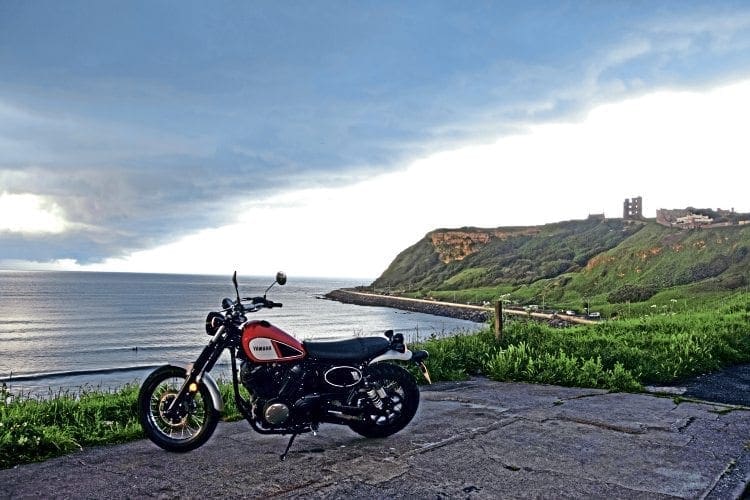
It was pretty clear from the outset that it was never going to be much of a scrambler, not in any meaningful sense of the word, but with the retro market booming it seemed like a canny move by Yamaha, on a roll in recent years with the MT range, XSR and new R1. The journalists who rode the SCR950 on its official launch in Sardinia came back with faint praise. It was clearly flawed, what with its hefty weight of 252 kilos and ground clearance that had pegs scraping the first corner. But they also said it was a lot of fun, and that, to me, seemed enough to try and get hold of one of the first bikes to reach the UK. In fact, I think I got the first, collecting a bike from Yamaha HQ with exactly no miles on the clock.
Enjoy everything MSL by reading the monthly magazine, Subscribe here.

I’d originally planned on heading up to Derbyshire to ride the Dales for a few days, but having taken the bike for a quick spin around the block in Worcester it was clear that maybe the tight, narrow lanes of the Dales might not be that suitable, especially with their lumpy road services. The SCR950 seemed happier zipping about town, a wave of torque pushing it along, nice easy steering with those wide bars and yes, scraping the pegs on the first roundabout. It felt like the perfect bike for roaming along the coast, so I decided to head east to Skegness instead and figure things out from there. Not able to secure a dry bag on the back, I packed a few things in a backpack and took off, hoping to sort out some cheap accommodation along the way.
SURPRISING START
The bike on the M69 towards Leicester was something of a surprise. Despite the lack of screen the buffeting on the motorway was minimal, except for that parachuting effect across the chest when the wind was head on. The speed was oddly deceptive. It never felt like you were going very fast, the lazy, low revving V-twin and the belt driven rear wheel never really giving off any great sense of propulsion, but then you’d look down at the speedo and see a surprising figure. The noise was good too. Gruff and rumbly. Even the riding position was relaxed and surprisingly comfortable and for once on a bike, to my mind at least, I actually thought I looked quite cool.

Originally from Mansfield in the East Midlands, I called in to visit friends on the way through to the coast. My grandmother had passed away recently, compelling me to travel via the nearby town of Shirebrook where she’d lived all her life. The place was once a thriving mining town until the pits shut in the Nineties and it never really recovered. The significance of Shirebrook for this trip to the East coast was the historical connection between here and other ex-mining towns in Derbyshire, with pits taking it in turns to close down for a week in the summer in order to allow their men to go on holiday to the likes of Skegness, Ingoldmells and Mablethorpe. They even sold the local Mansfield paper – the Chad – in Skegness, such was the influx of holidaymakers from that specific region.
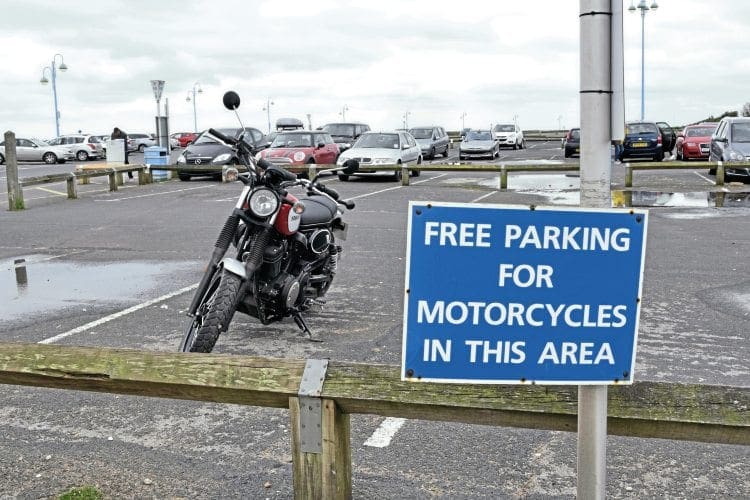
As a child I holidayed in Skegness at least twice, if not three times a year. Some might call that child abuse, but I always liked the place. There was then an element of nostalgia about this trip, which is also why I probably headed in this direction rather than to the Dales. Lincolnshire in particular must be one of the most underrated counties in the country. It has such big skies and compared to the saturation of towns and cities down the centre of the country, doesn’t seem to have very much in it. The SCR950 was perfect for these parts, and with the landscape and the bike it felt like I was in the midsts of one of those American road movies. Lone Rider to Skegness.
SCRAMBLING BY THE COAST
I passed the stock car racing arena on the outskirts and rode alongside the dykes, first into Ingoldmells, then along the main road past Butlins and on towards Skegness itself. The place is well kept and clean, with a multitude of amusement arcades, fish and chip emporia and a surprisingly well kept gardens and sea front. A forest of wind turbines now rises up from the bed of the North Sea. A man in a mobility scooter – a vehicle of choice around these parts – stopped to admire the bike and ask how I was getting on as he’d read all about it. I told him about the ground clearance but the rest was thoroughly positive. Not since riding a Royal Enfield Bullet has a bike been on the receiving end of such positive attention.
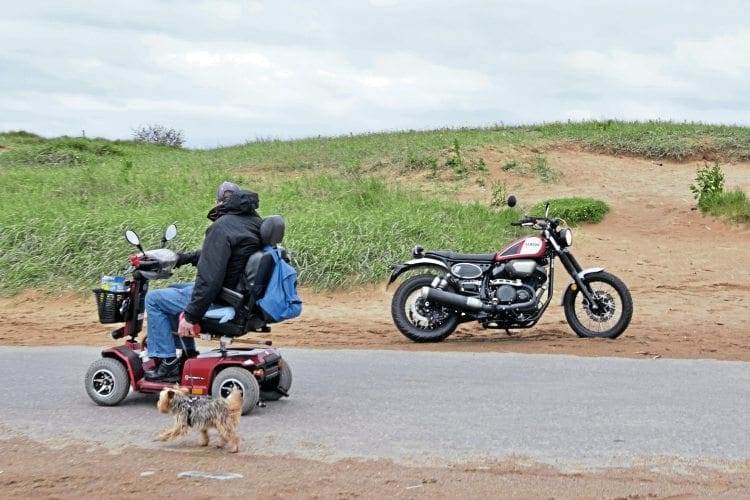
While eating a tray of chips and peas in a cafe by the clock tower I checked online to see if I could find any accommodation somewhere to the north. The YHA in Whitby had a bed in a dorm for a tenner and keen to keep costs to a minimum I made the booking. When travelling with a tent I tend not to worry where I’ll end up on an evening, as you can always pitch down somewhere. But reliant on hotel or formal accommodation it does cause a little anxiety if you don’t have anywhere booked. This then settled the nerves and gave me a good six to eight-hour window to slowly work my way up north.
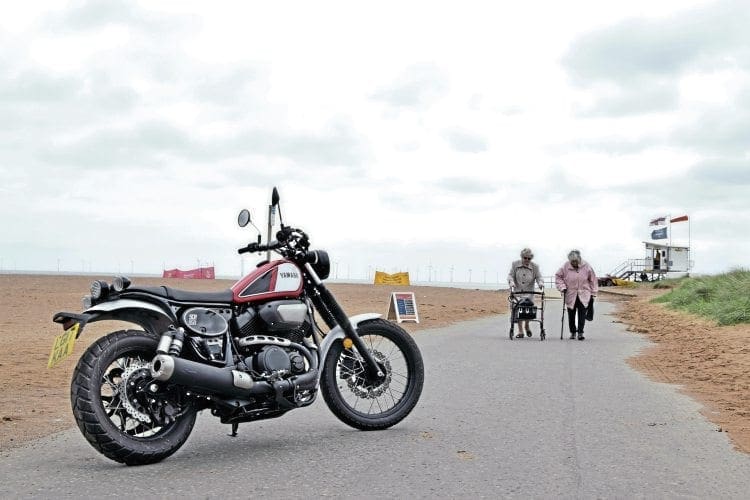
Not far out of Skegness, heading in the direction of Mablethorpe, I spotted a lane that was signposted to the sea and so turned off, following a lane until finally I stumbled upon Huttoft Car Terrace; a long beachside stretch of concrete where cars and camper vans park up and stare out at panoramic views of the muddy ocean. It was a busy little spot that morning; a row of retirees reading newspapers or pouring tea from flasks as a huge JCB fortified the seas defences in front of them. Finding this place was a reminder, much like a trip I did along the Devon and Cornish coastline on a Suzuki VanVan 200 last year, that the best stuff is often found when venturing off the main road. The SCR950 was also proving a solid and enjoyable bike for this sort of exploration. The low centre of gravity and manageable seat height of just 830mm makes it easy to U-turn, as does the smooth low speed power delivery. For the lumpy lanes I was now exploring the bike could have done with a bit more suspension travel.

Front and rear are unchanged from the XV950, with 135mm at the front and 110mm at the rear. This is fine for most open and flowing A-roads, but quite choppy on rougher surfaces, jarring through the spine if you hit something with a blunt front edge. Fuel range was average, the light coming on at just 100 miles, with about another five litres of the 13-litre tank in reserve. It’d probably be good for 150 miles at a push, with it averaging 58mpg when I stopped to add it up.

Heading inland towards the Lincolnshire Wolds I spotted a dirt track and headed down it in order to see how the bike coped off-road; to see if it really was much of a scrambler. As expected, it was the ground clearance and also the width of the pegs that hampered it the most. It’s certainly not a comfortable bike to stand up on, that wide splay of the legs robbing you of control and making for a tiring position. On smoother surfaces, staying in the saddle, the bike would probably be a bit of fun, but a scrambler it most certainly isn’t.
OVER THE HUMBER
After a bacon sandwich at the bike friendly Route 18 Cafe on the A18, I headed for the Humber Bridge and the city of Hull beyond. In 2015 Hull was voted second worst place to live in the UK, with Bradford rated the worst. It didn’t look that bad to me, especially the bit around the base of the bridge, where I found a car park right in the shadow of the towers on the North shore. To think the bridge was only built in 1981, with the only option before then to either ride a ferry that once ran across the Humber, or take the long road around the estuary. For 17 years it was the longest single-span suspension bridge in the world, until one opened in Japan in 1998. Now it’s only the eighth.
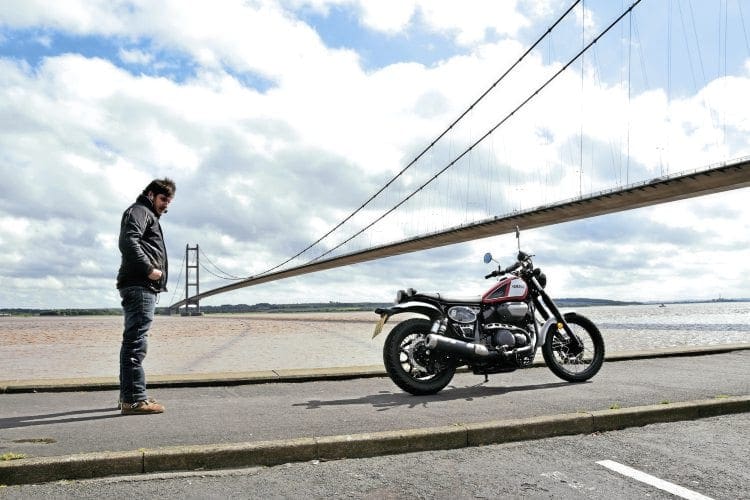
Rather than straight up to Scarborough on the A165 I took the A1033 in the direction of Patrington and Withernsea instead, surprised in Withernsea to find a lighthouse buried among and towering above the residential streets. The B1242 was an even bigger surprise, a road barely noticeable on the map but one of the best biking roads I’ve ridden for quite some time. Well-sighted, a mixture of tight and sweeping turns, switchbacks and even at evening rush hour not a great deal of traffic. The pegs scraped a couple of times but it didn’t diminish the fun and once you get the hang of it you can still keep good speed through the corners, just adapting a different technique to keep the bike more upright and avoiding the drag of the peg.
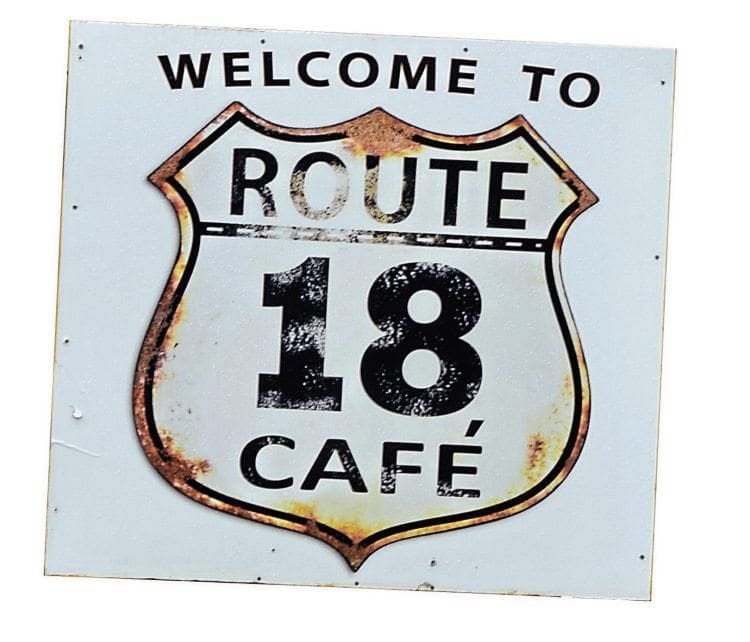
Hornsea and Flamborough Head followed and by the time I’d made the approach to Scarborough the sky was beginning to blacken with rain and thunder. I pulled in to the start of the old Scarborough road, now closed with a gate across. It still offers a good spot to gaze down upon Cayton Bay, as exotic a place as I’ve seen in a long while. It was a beautiful spectacle, especially with the menacing clouds, streaked by sunlight, bringing strength to the colours below. I was keen to get to Whitby now but Scarborough is always worth passing through, heading down to the harbour and on towards North Bay, where paddle boarders out on the ocean were best placed to brush off the impeding downpour. It came and everyone got wet, seeking shelter in the cafe, talking to a chap who’d recently acquired a vintage Kawasaki KL250 scrambler that he’d only just got working properly. His was the real deal, less than half what the SCR950 weighed and certainly capable of being taken off-road.
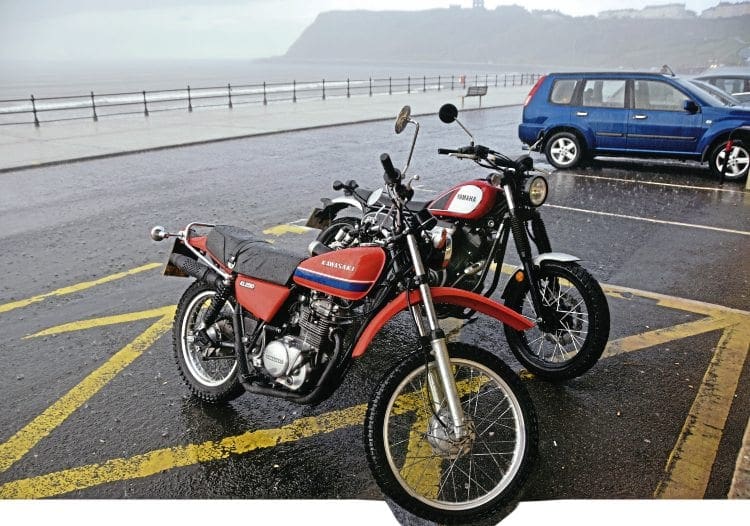
When you look at the evolution of motorcycling in that momentary two bike snapshot you can’t help but wonder how we ended up at this point; where we have bikes with badges to help them sell but which aren’t entirely accurate but don’t need to be because as buyers we’re still happy enough to go buying them. You do have to wonder though whether if manufacturers came out with very simple, very desirable machines, such as a lightweight, stylish scrambler, they might then be able to capture the imagination of the wider public and bring new people to motorcycling? Imagine if Yamaha brought back a truly noteworthy rendition of the XT500. That would be something else.
FROM BACK ROADS TO MOTORWAYS
After the rain had stopped it was time to ride up to Whitby via the A171. This is a great road. Watch the tight corners and sudden dips, and be sure to take a detour down into Robin Hood’s Bay. Also be prepared for the sight of Whitby as you crest the hill and see it open out beneath you; the contours of the coast framing the harbour like a picture, the ruins of the old abbey above it. With moody purple clouds and shafts of evening sunlight still strobing through it was as dramatic a night as I’ve seen for a long while. The path into the youth hostel is also a memory, passing through the grounds of the abbey and into the courtyard, which is perfectly safe for leaving your bike. On the evening I wandered into town and walked to the end of harbour. Lovely spot Whitby, my grandmother’s favourite place, and easy to see why.

I woke early the next morning and hit the road, heading west, then south on the A169 and into Goathland, which didn’t seem to have readied itself for visitors just yet, so rather than rejoin the A169 I to Pickering I took the back road out of Goathland, towards Key Green, then left onto Wheeldale Road, a single track moorland road all the way into Pickering, just more to the West of the town. There were some fords to cross along here, and for the most part I didn’t see another soul. It was lovely riding along here and well worth hunting it out. From Pickering to Helmsley, through the Howardian Hills and the grounds of Castle Howard, before emerging out on to the A64, to York, then towards Leeds, before reluctantly joining the MI for the long road back to Worcester.

With more time you could saunter down through the Peak District and make a really nice loop of it. As it was, I drew my conclusions of the SCR950 on the motorway, battling the cross winds and surge of weekend traffic as I reflected on bike and trip, that in the end would total 750 miles over two and a half days.
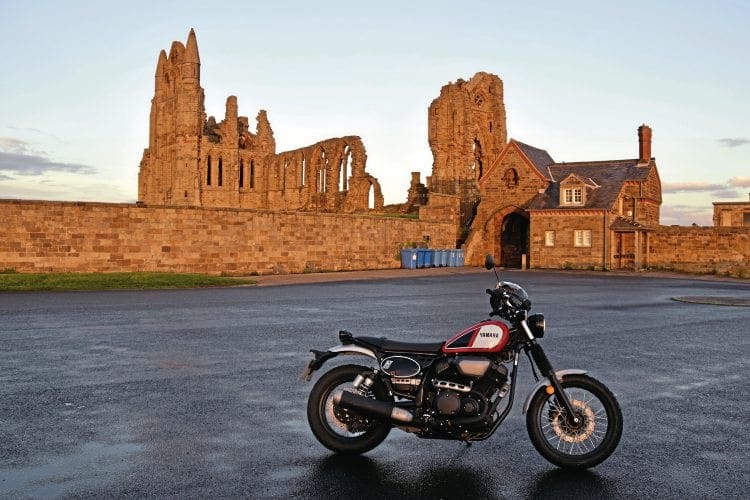
Objectively the SCR950 is not a perfect bike. It’s not particularly fast, nor comfortable for doing 250 miles a day, nor good at touring or corning or even being particularly cheap to buy. And yet at the same time it’s one of the most enjoyable bikes I’ve ridden for a long time. There’s just something about it. The lazy torque of the engine, the riding position, the styling; it makes for a bike that you just want to ride, and find excuse to ride. I usually need a reason or purpose to go out on the bike. But with the SCR950 I just wanted to jump on it and take it for a quick blast around town or back to the seaside. Measured in the way that magazines usually assess new bikes – power, cornering, technology – it might fall short, but measured from the saddle in the midst of a road trip, I would say it was something quite spectacular.
TRAVELLING LIGHT
Taking off on the spur of the moment for a few days on the bike is one of the things I enjoy the most. On this trip I just took a change of underwear, toothbrush and paste, a camera, tripod, phone charger and wallet. Ideally a tank bag would have been used but I didn’t have one to fit the SCR950. It would be easy to overpack for a trip like this, picturing the things you might need, and soon filling bags, panniers and clutter. Think instead of things you’re definitely going to need and forget the rest. Had there been a place to secure a dry bag, I would have taken a simple camp pack of tent, mat, and sleeping bag. For such a short trip I would source food nearby rather than pack a stove. For me, I like this simplicity of bike travel and you wouldn’t need to upscale much further to allow you to be on the road an extra few days – just pack more pants and socks.
YHA
Youth hostels might not be everyone’s cup of tea, but in terms of cost and convenience they can offer a great resource for bike trips of all durations. There’s a total of 193 YHAs around the UK, not counting the many independent hostels offering similar facilities. Dorms rooms are simple, usually split into genders and cheap, especially if booked early. Most places offer food at an extra cost, have free (albeit slow) wifi, and some offer camping too.
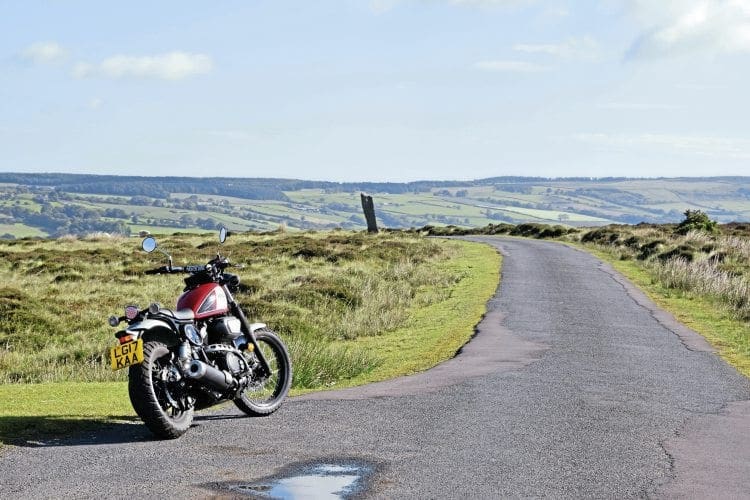
The benefit for those on a budget is that you’re getting a roof over your head for the price of a tent pitch on a commercial site. The YHA in particular also has facilities in some stunning locations; the one near Land’s End in St Just is especially noteworthy, as is the one at the abbey in Whitby where I stayed at in this trip. See www.yha.org.uk for more information on YHA facilities.
Specification
YAMAHA 5CR950 (2017)
Price: £8699
Engine: 942cc, air-cooled, eight-valves, SOHC, V-twin
Power: 53.5bhp (39.9kW) 5500rpm
Torque: 53.6lb-ft (79.5Nm) 3000rpm
Transmission: 6-speed, belt driven
Frame: Double cradle
Suspension: (F) Telescopic forks, 135mm of travel (R) Twin shock, 110mm of travel
Brakes: (F & R) Single dist, 298mm
Tyres: Bridgestone Trail Wing (F) 100/90/19 (R) 140/80/17
Seat height: 830mm Kerb weight: 252kg
Fuel capacity: 13 litres
Contact: www. yamaha-motor.eu/uk
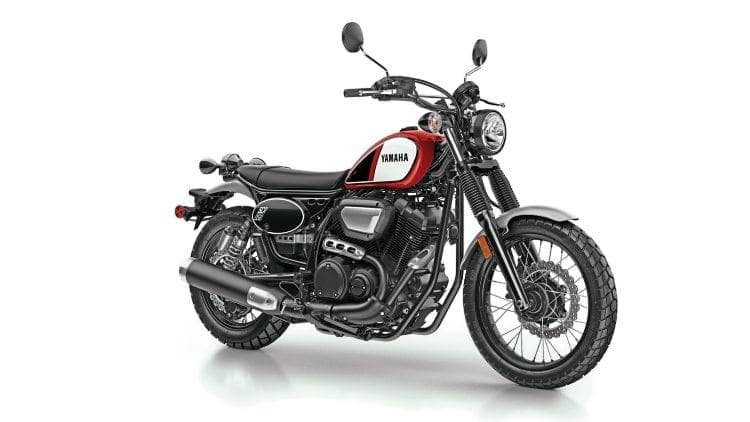
SEAT:
The SCR950s new sub-frame raises the seat height from the XV’s 690mm to 830mm. The new bench seat is mostly comfortable for 250 mile days.
FUEL TANK:
The new 13-litre tank is seam free and the colours pay homage to the XT500. Quality through the rest of the bike is varied. There is some cheap cabling and painted brackets that soon rub,
HANDLEBARS:
New wider handlebars give good leverage, with a foam crossbar pad sporting the name Faster Sons; Yamaha’s official tuning arm who offer accessories for the SCR950.
CLOCKS:
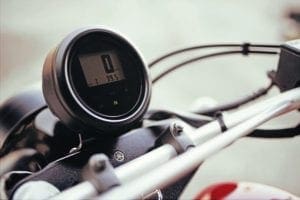 The clock is similar to the XV’s; a single round black unit with a few warning lights and a square digital display offering basic details of speed, mileage, time and trips A and B.
The clock is similar to the XV’s; a single round black unit with a few warning lights and a square digital display offering basic details of speed, mileage, time and trips A and B.
WHEELS:
The 19in front wheel helps raise the ground clearance by 10mm to 145mm. Tyres are Bridgestone Trail Wing dual-purpose tyres.
ENGINE:
The 942cc air-cooled V-twin offers 53.5bhp and 53.6lb-ft. Acceleration is brisk rather than startling. It’s low revving and well-suited to the bike. Fuel economy for the trip was 58mpg.
Closest Rivals
The Harley-Davidson Sportster Iron 883 is a good comparison. Cheaper to buy at £7995, with similar weight but with 10Nm fewer torques, the Harley is the quintessential weekend cruiser. Whether it has the understated appeal of the Yamaha badge remains to be seen and in reality the two bikes will probably attract a very different audience, despite their mechanical similarities.
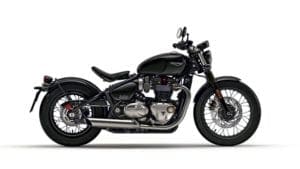
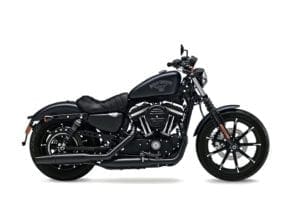
Perhaps more comparable, from a consumer’s point of view, is the new Triumph Bobber. More expensive than the Yamaha but also better detailed and more powerful, but again, is it too obvious a choice and possibly over-reaching in trying to be cool. The Triumph Scrambler would probably hold more similar appeal to the SCR950, while Ducati’s Desert Sled could be the bike to have if genuine off-road thrills are what you want from your modern day scrambler.
Words: Nathan Millward
Photography: Nathan Millward & Yamaha
[googlemaps https://www.google.com/maps/d/embed?mid=1OJHQut8hO6H0jfQ0o6xmaChHwW4&w=640&h=480]






